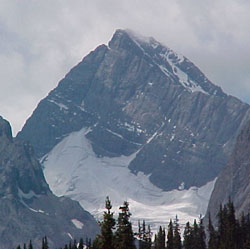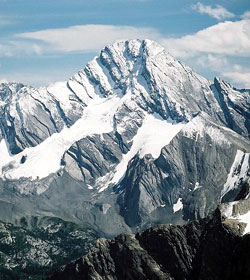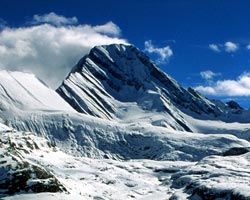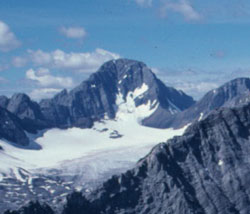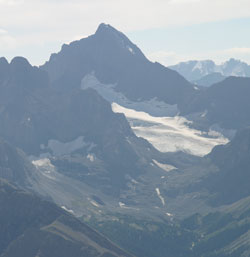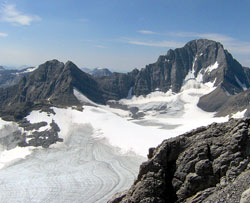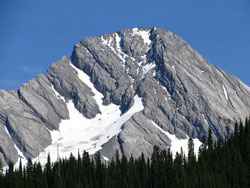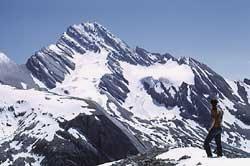
Photo: Mount Sir Douglas from Burstall Pass
Mount Sir Douglas
- 3406 m (11,174ft)
- First Ascent
- Naming History
Located on the continental divide in the upper Spray River and upper Palliser River Valleys; 3 km ENE of Palliser Pass
Province: Alberta/BC
Park: Kananaskis/Banff
Headwater: Bow/Kootenay
Visible from Highway: 40S, 742
Ascent Party: J.W.A. Hickson
Ascent Guide: Edward Feuz jr.
Named for: Haig, Field Marshall Sir Douglas (Field Marshall Haig commanded the British Armies in France during WW I.)
A most impressive, high, glacier draped peak, Mount Sir Douglas lies at the southen end of Banff National Park. Burstall Pass provides an ideal viewpoint for this very high mountain. Evidence of the mountains significance is the fact that J.W.A. Hickson, a well-known early climber in the Canadian Rockies and guide Edward Feuz jr. journeyed this far south to complete the first ascent in 1919. George Dawson's 1886 map shows only one named peak in the Spray Range. He identifies Mount Robinson in the approximate location of what is now Mount Sir Douglas. It is not known who Robinson was. SIR DOUGLAS HAIG (1861-1928) Field Marshal Sir Douglas Haig was born in Scotland in 1861 and educated at Oxford. Joining the British Army, he served as a cavalryman in the Sudan and South Africa and after the Boer War rapidly rose through the ranks. It is said that his many promotions were aided by the influence of powerful patrons such as Sir John French. When the First World War broke out two Haig commanded the British 1st Corps as part of the British Expeditionary Force in France. As the war became bogged down in the trenches he oversaw the terrible battles of the Somme - 57,470 British soldiers killed or seriously injured on the first day - and Passchendaele. "At the Somme you either got wounded or you got killed," one veteran commented afterwards. "At Passchendaele you got killed, wounded or you drowned in the sludge." Haig is often criticised for being a distant leader who was stern and unapproachable even to his own officers. In 1918 he extended the British section of the Western Front southwards, his troops again suffering terrible losses at the hands of a German offensive. The British counter-attacked and, aided by the American Expeditionary Force, the Allies eventually forced the Germans to seek armistice terms in 1918. Renowned for his loyalty to King George V, Haig dedicated his energies throughout the war to ensuring. After the war he devoted himself to the welfare of his men. He spent his later years criss-crossing the British Empire initiating charities to aid those who had served beneath him.
